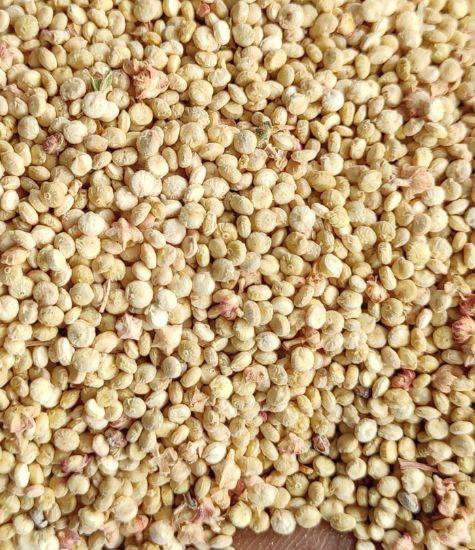Quinoa Seeds

Quinoa Seeds
Quinoa (Chenopodium quinoa) is a grain-like seed which is an individual from the Amaranth group of blossoming plants (Amaranthaceae). It is local to the Andean district of South America, where it was a staple yield for the Inca, Aymara and other pre-Columbian people groups. The Quechua name for quinoa means "mother grain" or "super grain," because of its unrivaled sustenance. Rumors from far and wide suggest that the Incan ruler would establish the first quinoa seeds every year in a serious yearly service — such was its significance to the Incan public. Quinoa is viewed as an old grain since it has not been modified for huge scope farming, and is a similar assortment developed for millennia.
- Detail :100% Organic
- Email address :vincentaasir@gmail.com
- Phone number :+91 8220499403
Quinoa becomes on three-to nine-foot tall fuchsia stalks. The enormous seed heads can be almost any tone — red, orange, purple, green, dark and yellow are normal. The plant is impervious to dry season and fills well in unfortunate soils without water system or supplementation. The World Wellbeing Association sees that quinoa is nearer to the ideal protein balance than some other grain, comparable to drain in protein and high in iron, magnesium, phosphorus, zinc, vitamin E and certain B nutrients. It is additionally high in fiber and fundamental amino acids, yet low in carbs.
Quinoa has become well known in the U.S. furthermore, all over the planet, because of its great dietary profile as well as its one of a kind, fragile surface and flavor. At the point when cooked, the dainty microbe that surrounds the grain to some extent disengages from the seed and remains marginally crunchy, while the actual seed, silvery and clear, turns out to be delicate and feathery. Quinoa has a marginally nutty flavor and is a decent substitute for rice, couscous or bulgur in many dishes. It can likewise be ground into a flour for use in baking.
Quinoa arrives in a scope of varieties. The most notable assortment is white, yet red and dark assortments are progressively well known. Contrasted with white quinoa, the red assortment holds its shape somewhat better in the wake of cooking, while dark quinoa has a marginally earthier and better flavor. Our quinoa has its regular, severe tasting saponin covering eliminated for quinoa that is prepared to cook without washing.
| Property | Value |
|---|---|
| Scientific Name | Chenopodium quinoa |
| Common Name | Quinoa |
| Origin | Andean region of South America |
| Color | White, red, black |
| Texture | Small, round grains |
| Nutritional Content | Rich in protein, fiber, vitamins, and minerals |
| Gluten-Free | Yes |
| Cooking Time | Approximately 15-20 minutes |
| Uses | Consumed as a grain, used in salads, soups, and various dishes |
